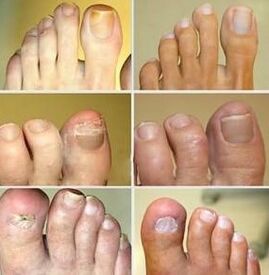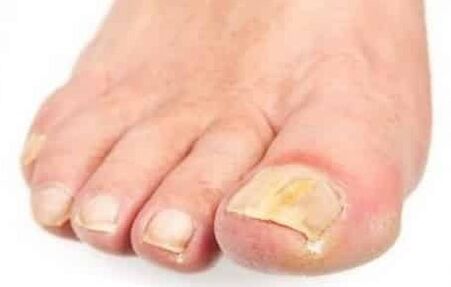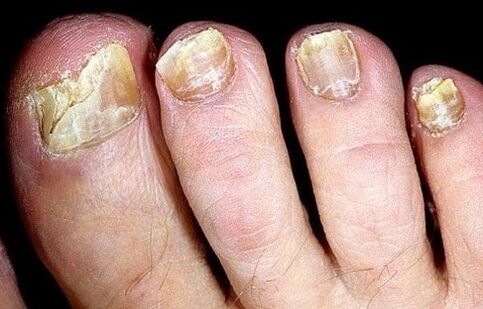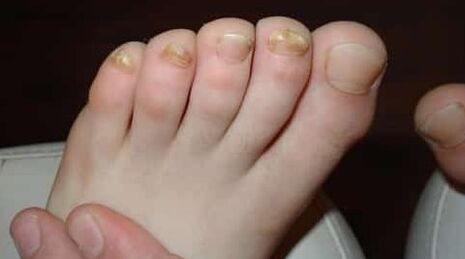Onychomycosis is a pathology that destroys nail plates.Cork, keratin eats - the construction base of the nail.The infection is closed to each other and begins to divide.In the leading stages, the pathology can affect the skin of the foot, intercal zone and heels.

Reasons for nail fungi
Something infected with onychomycosy is quite easy.Infection can be lurk in the Pool, in the public, in the beach.A fungi is more likely to catch infected relatives or acquaintances (using common life).
There are several main conditions that may incite the virus to enter the human body:
- Weak immune system - a reduction in protection forces due to infectious or inflammatory diseases;
- Violation of the internal organs (diabetes) affairs (diabetes) of blood circulation in low extremities of vascular pathologies;
- Minor damage to feet caused by intense shoes (wear, mousts, corns, corns, corn);
- ignoring the diaper rash of lower extremities and intensively;
- Violation of attention measures - to test someone else's shoes, visit public places without slippers and neglect the legs of the legs.
Types of nail fungi
Onychomycycis can cause several types of fungi.Dermatophytees, for example, appear in the cloud of the nail.There is a formation of yellow spots along the edges or in the middle of the plate.In addition, long-term strips can be observed along the affected area.
Maya mushroom provokes the deformation of the nail plate.It is very complicated and starts to move away from the place, gray.In the wounded cells, the metabolism is deteriorating, and the nail rollers appear in the nail rollers.In addition, the neighboring epidermis appears in inflammation, edema, redness, the disappearance of nail skin.
Mold bacteria If there are diseases that provoke nail nutrition disorders, can injure the nail plate.In this case, a clouding of the plate, a change in color (open yellow and greenish brown and even black).
You should contact a specialist to find the cause of the negative changes in the skin and nails and to find the pathogen.The disease may be full of independent identification and treatment without appealing to the doctor.
Stages of the disease

The micosu of nails gradually affects healthy cells.There are several stage of development of the disease, each of which is reflected in itself.
The first stage of onyokomycosis (normotorofiti) has no bright manifestations.In most cases, the secret continues.First signs - the nail decreases slightly, the color change, microcrast and yellow spots occur in the form of circles or sensitivity, and will appear.An inexperienced mushroom can be accompanied by itching and burning.Since symptoms are similar to other diseases (psoriasis, liver pathology), it is difficult to recognize the infection properly at the initial stage.
If treatment does not start on time, the disease will go to the next stage - hypertrophic.The nail is thickened, dark.The slab has a deformation of its crowning and destruction.
The advanced form of nail disease shows itself with a strong tenderness of the nail plate, which leads to further rejection.The adjacent skin is blue, an unpleasant odor.
Symptoms
Onychomycocosition most nails affect the nails on the foot, the hands suffer less.The disease begins with your thumb and small finger (outer edge touches), is smoothly affected by all tiles.
The leading symptoms of the onychomycosis will help you determine the fungal infection:
- The appearance of whitening or greenish colored strips and spots under the nails;
- Clouding of the plate, a change in color (from yellow from the yellow dark brown);
- Redness and peeling of skin around the nail;
- appearance of rudies between legs and fingers;
- Mold in nails.
Types of mushroom diseases of nails
Onychomycosis is commonly classified by the appearance of affected areas.Classification feature differs in three types, depending on clinical manifestations, because the nails are similar to the mushrooms:
- Atrophic or onholitic - significantly affected by nail plate, to the degree of refusal from nail bed;
- The natural glow is lost, the color of different types of deformations (more material) and structure (more material), and even destroys the edges;
- NAmantrophic - Nail plate is characterized by the lowest damage rate due to the appearance of the appearance due to the color of natural transparency and other visible changes in natural transparency and color.

In foreign countries, the mushrooms in the nail mushrooms have another classification that the lesion is divided into species:
- Total in which the entire nail plate is covered by a pathogenic process;
- Distal - The form of damage to the localization of the free edge of the nail is above the end of the fingers;
- Proximal to the free edge of the nail, which is located under the clutter from the bottom of the slack from the bottom of the nail ();
- The form of damage affecting the sides of the nail plate.
What does the pathology look like
Among the population, mushroom nail diseases have foreign similarities with other dermatological diseases of negriting nature.Depending on the pathological phase, nails begin to look harmless because they lost natural glow and transparency.Smooth and even they are thickened and deformed and covered in different colors (often white or dirty yellow).Soft tissues covering the keratin layer in the damaged by the parasite are also involved in inflammatory reactions, swollen and ulcer.
If we take into account the dynamics of the disease of the destruction of the nail plate, then it is divided into three consecutive stages:
- In the first stage, there is no practical no sign, except for light boring, dots or stripes on the plate.
- In a quick stage, all the signs of the onychamycosis are clear in a stage, which quickly replaces the beginning.
- Advanced stage, the last degeneration of the nail can be added with the appearance of an unpleasant odor of rotting tissues.
Causes of deformation of the nail
Molds, mushrooms and dermatophithic fungi, such as a similar symptoms, cause infectious diseases of nails (onychomicosis).Change all types of nails on the feet or in the arm, deformation, transparency, radiance, color on the nail plate.The changes in the nail are found not only onychoolicos and injuries, chronic paronichia (nail roll inflammation), psoriasis, hand exembies, dermatitis.You must review all possible options before drawing out a conclusion related to Mungal infection.
Symptoms of fungi
There are different classifications of nail fungi, depending on the type and manifestation, so it can have completely different signs and symptoms, so it is very important to determine it (psoriasis, eczema, street, lichen and dermatophytophy).Review the symptoms of the mushrooms and signs of the feet and weapons, immediately after the surface of the surface on the top of the thumbs.
- Thickened plate;
- Fragile, crushed or torn or torn nails are just near the edge, but also across the surface;
- Distorted forms, defective structure;
- The initial stage is a loss of brightness and elasticity;
- If the nail is blackened (if a person works in regularly stained compositions or mechanical parts);
- Nails crash under the skin;
- DysBacteriosis begins, perhaps a common decline in immunity, strength and drowsiness;
- Itching between fingers and feet is especially pronounced to the child;
- The examination of the nail deposit is a very common event and is almost the last stage before the full loss of the nail called Onycholisis.You can feel pain in your fingers and find a slightly unpleasant odor;
- The skin becomes dry, crack, a rash appears, perhaps blood or a soucon appearance;
- Under the nail a mold white or yellow circle, depending on the diversity of fungi, may be bright, dull, disclosed edges and muddy structures.

Before starting active movements, it is necessary to eliminate, eliminate the negative impact of the external environmentReasons for the visibility of the mushroomUnder the legs' fingernails:
- Ideal for the growth of a hot and humid environment, different microorganisms, then try to dry shoes after walking, and wear socks from natural materials that provide normal heat and air exchange;
- Foot mushrooms often appear due to poor immunity, simply step on the ground with your naked leg and take the infection, take vitamins to prevent it;
- Often the nail extension can be one of the reasons onychomycosis, restricts the procedure up to 1 in six months;
- The most complex sympathetic - this is a mushroom created by active disputes.Penetrates the cavities between nails and fingers, may be in a sleeping stage for a while and then can grow sharply.Often, other people's shoes, etc.
Total types of STOP micosure
There are many ways to get an infection with the mushrooms of the legs, but it is possible with direct contact with pathogen.Often, this happens in violation of other people's shoes or personal hygiene rules.Skin mushrooms in the legs indicate itself through the destruction of the dermis, which is usually reflected in the form of peeling.In this case, the epidermis destroys the lesions of the epidermis, destroying the infection and penetrating the deep layers of the infection.
Modern medicine, each identifies the following options for mushroom damage to the feet distinguished in symptoms and treatment options:
- Intodallic Mikos is the most common shape in the form of the self-manifestation of the disease.The symptom usually appears between 4 and 4, less than 4 and 5, a cracked crack with a white film.It is possible to delete a certain amount of liquid, borders, as well as the appearance of diapers.The signs of the legs interdigital mushroom can be accompanied by weak itching.In the fingers of the legs, such a fungus can occur completely without symptoms, but there is an important change in the future in the future.
- The mushrooms of skumous hyperkeratosis may differ from other types by severe peeling and epidermis.Basically, atopic is characteristic of people suffering from different types of dermatitis.This is the type of disease in the feet of fungi.The main symptom of the disease is a terthema, a painful pink nodule, which is the effective area affected by clean boundaries.It is accompanied by weak itching, cracks, dryness, pain, wrap, and nail plates.Onychomycosis generally leads to treasuring nails, accompanied by this type of cork;
- Vesicular mushrooms are one of the types of rarest infections that affect the skin of the legs.The names of the disease took the name for the formation of vesiculations - the bubbles with liquid content occur erosion, which is dangerous for infection.Mongal vesicle Vesicosis Variability: 1 centimeter's appearance of blisters, which is diameter, as well as weak itching;
- Mushrooms have been deleted.At the initial stage, the appearance of small cracks, which affects the legs of the legs, as well as the upper layer of epidermis, has the appearance of small cracks.
- Mushrooms are disibled in the inheritance experience in 8% of patients with 8% of patients in Mikoza.It is mainly localized in the only meat and the sole of meat, gradually combined and united in the form of bubbles, then the gap is then occurs as a result of the emergence of erosion.This type of fungi is the opportunity to combine bacterial infection, because pathogenic microorganisms easily penetrate easily with penetration of the wound;
- The intermikal mikosis is not only independent, but also as an accompaniment of the mushroom of the feet as an accompaniment.Severe itching and combustion, diaper rash and the appearance of the legs characterized by the appearance of erosion;
- Onychomycosis is another general damage to the nails of the nails on their feet.This is usually developed from the free edge of the nail plate, the initial stage is characterized by the appearance of yellow spots, after which the disease is progressing with the full leave of relaxation and the nail.Often accompanies other forms of fungal lesions;
- The main mushroom is also called localized yeast erosion in Interigin.In this case, the mushrooms on the foot seem to be a concentration of inflammatory swelling areas that can be surrounded by pustules of small form.

















